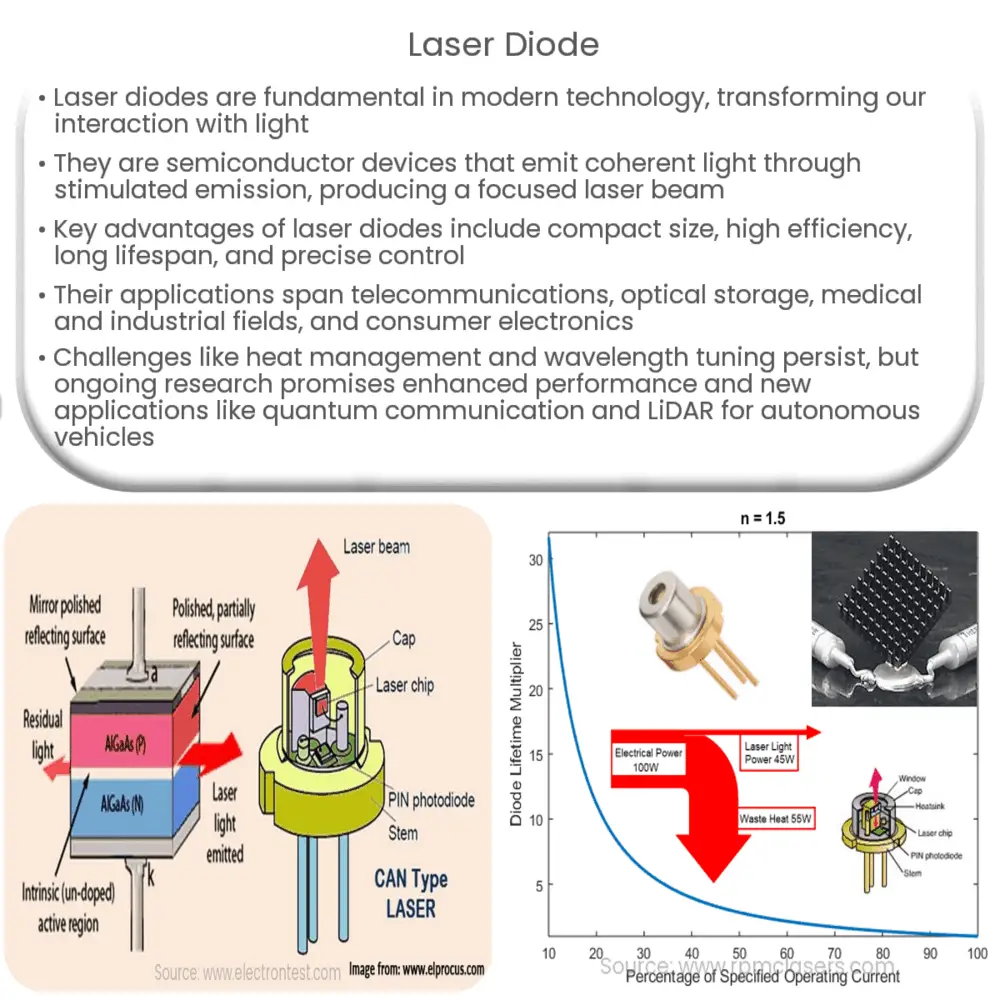A laser diode is a compact semiconductor device that emits a highly focused, coherent light beam, used in industries such as telecom, medicine, and manufacturing.

Laser Diode: An Introduction to the Future of Light Technology
Laser diodes have become a fundamental component in modern technology, providing a wide array of applications in various industries. These tiny yet powerful light sources are revolutionizing the way we perceive and interact with light in our daily lives. In this article, we will explore the basics of laser diodes, their working principle, and some of the most prominent applications that have emerged in recent years.
What is a Laser Diode?
A laser diode is a semiconductor device that emits coherent light through the process of stimulated emission. It consists of a p-n junction, which is formed by combining a p-type semiconductor material with an n-type semiconductor material. When an electric current is applied to the junction, electrons and holes recombine, releasing energy in the form of photons. This phenomenon produces a highly focused and intense beam of light, commonly referred to as a laser.
The Working Principle of Laser Diodes
The principle behind the operation of a laser diode is based on the interaction between electrons, holes, and photons within the p-n junction. When a forward bias voltage is applied across the junction, electrons from the n-type material are injected into the p-type material, where they recombine with holes. This recombination process results in the emission of photons, which are in phase and have the same wavelength.
The emitted photons travel within the semiconductor material, bouncing back and forth between the two ends of the diode. These ends are usually coated with a highly reflective material to form a resonant cavity that amplifies the light through a process called stimulated emission. As more photons are generated, they stimulate the emission of even more photons, resulting in a coherent and highly directional laser beam.
Key Advantages of Laser Diodes
Laser diodes offer several benefits that make them suitable for various applications. Some of the key advantages include:
- Compact size: Due to their small dimensions, laser diodes can be easily integrated into a wide range of devices, from portable gadgets to industrial equipment.
- High efficiency: Laser diodes have a higher conversion efficiency compared to other light sources, as they directly convert electrical energy into light energy with minimal losses.
- Long lifespan: With proper heat management, laser diodes can have a long operational life, making them a cost-effective solution for various applications.
- Precise control: The output of a laser diode can be easily modulated, allowing for accurate control of the intensity, wavelength, and direction of the emitted light.
In the next part of this article, we will explore some of the most prominent applications of laser diodes in various industries, along with the challenges and future prospects of this technology.
Applications of Laser Diodes
Laser diodes have found widespread use in a multitude of industries, thanks to their unique properties and advantages. Some of the most prominent applications include:
- Telecommunications: Laser diodes are essential components in fiber-optic communication systems, where they convert electrical signals into optical signals, enabling high-speed data transmission over long distances.
- Optical storage: Laser diodes are used in devices such as CD, DVD, and Blu-ray players, where they read and write data by focusing a laser beam onto the surface of a spinning disc.
- Medical applications: In the medical field, laser diodes are used for various procedures, including laser surgery, photodynamic therapy, and optical coherence tomography.
- Industrial applications: Laser diodes are employed in manufacturing processes, such as laser cutting, welding, and marking, due to their high precision and efficiency.
- Consumer electronics: Laser diodes are found in everyday devices, including barcode scanners, laser printers, and laser pointers.
Challenges and Future Prospects
Despite the numerous benefits and widespread adoption of laser diodes, there are still challenges that need to be addressed to further enhance their performance and expand their applications. Some of the key challenges include:
- Heat management: High-power laser diodes generate significant amounts of heat, which can lead to performance degradation and reduced lifespan. Developing better heat management solutions is crucial for improving the reliability and longevity of these devices.
- Wavelength tuning: The ability to fine-tune the wavelength of a laser diode is essential for certain applications, such as spectroscopy and sensing. Researchers are working on developing novel materials and structures to facilitate precise wavelength control.
The future of laser diodes appears promising, with numerous research efforts focusing on enhancing their performance and exploring new applications. Some potential future developments include:
- Higher power and efficiency: Ongoing research aims to develop laser diodes with higher output power, greater efficiency, and improved beam quality, which will expand their use in more demanding applications.
- Quantum communication: Laser diodes could play a crucial role in the emerging field of quantum communication, where they may be used to transmit quantum bits (qubits) over long distances.
- LiDAR and autonomous vehicles: Laser diodes are a key component in LiDAR systems, which are essential for the operation of autonomous vehicles. Continued advancements in laser diode technology will contribute to the development of more accurate and reliable LiDAR systems.
In conclusion, laser diodes are an integral part of modern technology, with a wide range of applications across various industries. As researchers continue to address the challenges and explore

